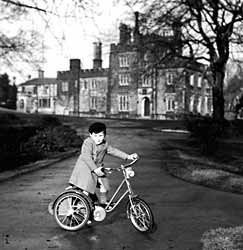
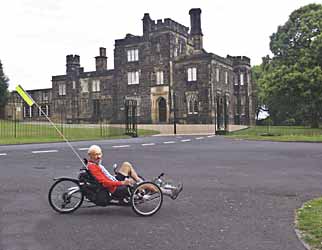


Before and after! On the left, c 1951, photograph by Fred Hessey (the trike is a Gresham Flyer). On the right, June 2006, photograph by Tony Callear (same rider, same location).
When Inspired Cycle Engineering (ICE) announced the 2006 version of their QNT recumbent tricycle the specification included rear suspension and the ability to fold/separate easily for portability. We tested the production prototype in January at ICE's Falmouth home, including a fairly short test ride. I was so impressed that I ordered one, but as they were not yet in production, and there was already a waiting list, mine did not arrive until the last day of March. As we had already published a short report, we have refrained from further comment until we had a chance to cover a reasonable distance. Actually the intention was to do this after 500Km, but after covering quite a lot of distance in the last 10 days that has extended to an 800Km report (500 miles), including three rides of over 100Km.
For completeness we have included much of our January report (specifications etc) here, with some appropriate updates, but you can read the whole original report, including the first impressions, at http://www.foldsoc.co.uk/triceqnt1.html.
Folding recumbents are pretty rare - Bike Friday make the SatrDay recumbent bike (recently completely redesigned), and Greenspeed now have some recumbent trikes that incorporate a simple fold to reduce the size. A new folding trike, the JM, is also apparently either close to being launched, or just about launched. By and large folding recumbents are still quite bulky, and seem very unlikely ever to be suited to train-and-cycle-commuting. (A kit to convert a Brompton to a recumbent bike was produced in Germany quite some while back, but, apart from anything else, you tend to need plenty of gears on a recumbent, so it was rather limited; now an SP recumbent based on a Brompton, with Rohloff gears and disc brakes would be interesting - any thoughts Steve?). I'm told that Richard Loke has been seen on a recumbent, so an Airnimal recumbent might appear some time, though as far as I know there are no immediate plans for one.
Inspired Cycle Engineering (ICE) is the leading UK producer of recumbent tricycles, and has established a very high reputation for its excellent machines, not just in the UK, but internationally (most of their sales are to overseas customers). Their models prior to this year (2006) could be dismantled to make a fairly compact package (the Mini, for example, could be fitted in a large Samsonite case), but this took a while, and was not a particularly major selling feature. In late 2004 they added a range of relatively cheap (well under £2000) ‘standard’ models to their more sophisticated and more expensive custom made models - the custom made models retaining the name ‘Trice’, while the new cheaper models were referred to as ICE recumbents.
For 2006, ICE have made some major changes to the standard range of machines, which now also carry the name Trice, with only a very modest increase in price. Although rear suspension was an option on some of the custom models before, it was not previously available on the standard models, but for 2006 it is now fitted on all the standard models as part of the basic specification. In addition, the 2006 standard models are designed to be much more portable (or just compact when stored) - the rear suspension system allows a first, quick, fold, and quick-releases are used for mounting fittings and much of the assembly of the machine, so separating the machine into smaller parts is fairly straightforward.
We visited ICE in Falmouth to look at and try one of the new models in January 2006, and reported favourably on it (including the ability to fold and separate to fit in a Smart car) - that report is on the web pages at http://www.foldsoc.co.uk/triceqnt1.html. The more observant amongst our readers may have noted the clue contained in the link address of this report - it ended in a '1' - with an implication that more reports would follow! As the earlier report indicated, I was very impressed by the specification, build quality, portablity (yes, it fitted in the Smart, with the passenger seat still in place, and room for a Brompton as well), and performance on the road, and though it was not mentioned in the report, I ordered one before I left. Production of the new models had not yet started at the time, and there was already a waiting list, so mine was not due to reach me until the end of March. We have delayed this second report until we had time to put some distance on the the machine, but the time now seems right to issue a more detailed report.
The Trice range is HUGE, and I can only refer you to their very extensive and informative web pages (http://www.ice.hpv.co.uk) for more details, at least of the custom-made (expensive) models. In the standard range, the various models are aimed at several specific primary uses (though obviously they are very versatile machines, and any model can do any job), with significant differences in frame design (eg width, height, length, seat angle) as a result, but in terms of general component specification they do not differ a great deal. The standard models are:
Q - Q stands for ‘quick’ - a fairly low model, but quite capable of being used not just for fast riding, but also for carrying luggage.
QNT - Basically the same as the Q, but with a narrower front track (giving an overall width of 78cm instead of 88cm), making it easier to get it through doorways, between bollards, etc. This is probably the most popular model of all those made by ICE.
S - Sport. Longer and lower, with a hard shell seat (rather than a mesh 'hammock' seat) and more of a performance machine, though still capable of luggage carrying etc.
T - T for Tour. This is a slightly higher design, which makes getting on and off a bit easier.
You can read the full specification of all the ICE machines on their web site, where there are also a great many pictures of both complete machines and the details of the standard range, so what follows is just a brief commented summary of the main features.
All the 2006 standard models feature the new rear suspension system, which uses as a suspension member the same elastomer as is fitted to the Birdy (3 grades of hardness, but the way it is fitted on the Trice allows each elastomer to be put into one of 3 positions, giving some adjustment without the need to change the elastomer). A Velcro strap prevents the suspension system folding if the machine is lifted. All the frames of the standard models fold and separate (using quick release levers) in the same way - more on this later.
The frame is easily adjustable for riders of different leg lengths, quoted as an X-seam measurement of 39 to 48 inches on the QNT (down to 37 inches if shorter (155mm) cranks are used). This is done by extending or retracting the front 'boom' which fits into the main frame, and is held in place by two bolts (allen headed as standard, or Quick Release heads with the additional QR kit). Since the adjustment moves the position of the cranks relative to the back wheel, anything other than a small adjustment for different rider leg lengths would probably necessitate adding or removing links from the chain though. The angle of the seat back can also be adjusted to one of 3 preset positions, and this can be done very easily, so you could choose the angle to suit the type of riding, or perhaps if you are new to recumbents, you could start with an upright position and then move to a more reclined one later if you are happy with it.
All the standard models use 20 inch (406) wheels front and back, which gives a huge choice of tyres and ready availability of spares; some recumbent trikes have a larger back wheel than front ones - not the case with the standard Trices, which means you don’t need to carry different spare tubes, and stock more than one size of spare tyre. Kenda Kwest tyres are fitted as standard (unfortunately the original tubes have Schraeder valves - I much prefer Prestas), which seem to perform well (the rear one is fatter than the front ones). For a trike, slightly more robust tyres are generally desirable, though Schwalbe Stelvios (a narrow, high pressure racing tyre) could be fitted to the front (though they are perhaps a bit fragile for use at the rear). The optional front mudguards have very large tyre clearances, so even the fattest tyres should fit without problems.
Standard gearing is a 9-speed Megarange 11-32 cluster and a triple chainring - 52/42/30 (with a customer-fitted option of 55 at the top, or 26 at the bottom, but not both at the same time). The standard range is therefore quoted 18.2 - 92.2 inches, or 18.2 - 97.5 for the high option, or 15.6 - 92.2 for the low option (based on my own tyre measurements I'd put the figures a fraction lower than this with the Kenda Kwest tyres). This is a very respectable range, and well chosen, though of course with a recumbent you can ideally make use of some really high gears (lower wind resistance), while needing very low gears for hill climbing. The new aluminium rear fork assembly is Rohloff-ready, though ICE do not offer this 14-speed hub-gear as a factory option (one of the development custom models in the factory had a Rohloff fitted). ICE now have information on how to fit a Rohloff in the manual that comes with these models, though in stating the pros and cons of this system they do imply a strong preference for the more conventional derailleur set up.
Braking is provided by Sturmey-Archer drum brakes at the front. Although there is no rear brake fitted as standard (the normal arrangement with ‘tadpole’ trikes, ie those with 2 wheels at the front), the rear frame forks have mountings to allow a rear disc to be added if required, which could then be used as a further parking brake (both front brakes can serve this purpose) or a ‘drag brake’ for use when heavily loaded. With two independently operated front brakes, questions might arise as to whether uneven application can result in ‘brake-steering’; while some makes of trike do still suffer this to some degree, ICE machines have built up an excellent reputation for absence of ‘brake-steer’ - more on this later. Drum brakes are probably used in preference to discs at the front to save on cost - more expensive custom-made Trices do use discs, as do most other trikes, but the Sturmey drums are well-regarded - more on this later in the road test section.
The standard Trices are very reasonably equipped for such relatively cheap machines, including a rear mudguard (quick fitting and removal), tubes over the long chain run to avoid the rider picking up oil and grease, one mirror and a flag for the rear. There is a wide range of reasonably priced extras, including front mudguards, a more robust, and longer, rear mudguard, computer mount, front light mount, adjustable neck rest, chain ring guard, rear disc (parking) brake kit, additional bottle-cage mounting kit (1 set of bosses are standard) and a pack to allow fast (QR) dismantling to a further level.
The 2006 standard models come without a rear rack (it was included with the 2005 models). A new rack has been designed for 2006, which mounts entirely on the suspended part of the frame (the right way to do it, unlike a number of folding bikes!); this rack is mounted via a quick release, so it is easy to fit and remove it, and the mudguard at the same time. Actually ICE are promoting Radical ‘side pods’ instead; these have a capacity of 12.5L each (25L total), and mount directly onto the seat without any separate carrier (they are a pair, so you can’t just fit one). There are also some Radical side panniers of 20L each, but these do require rack support on some models (not the S, but needed for the Q and T standard models). These bags work out much lighter than conventional panniers on the rack, and are cheaper too! The smaller side pods can be supplemented with a rack and conventional panniers if required. It is also possible to mount a bar bag on either (or both) sides of the frame using a special (optional extra) mount, though again the smaller Radical bags are probably a better option for most people (more capacity, lighter, and they can still be reached from the seat).
There are apparently plans to offer a carry bag for the folded/disassembled machine.
Incidentally, ICE are offering a kit to convert the 2005 models to use the rear suspension which is now on the 2006 models.
The machine arrived on 31 March (just when it was promised), and when I saw the UPS van pulled up outside I rushed downstairs so that I could help the young lady who drives the van get it up to the house - in fact, by the time I reached the front door she was already there, complete with a remarkably modestly sized box, and showing no signs of having found it a struggle to carry it unaided!
Inside the box the machine is fully disassembled, but very carefully packed, and with all the sub-assemblies, fixing components etc, enclosed in plastic bags. As I've never assembled (or owned) a recumbent trike before, I decided I should work through the assembly manual very carefully, and take photographs as I went along, in case these were required for this report (unfortunately in the excitement I seem to have lost all these photographs!). Perhaps for this reason, despite the excellent instruction manual, it took me almost 8 hours to put it together. Probably the most awkward job was fitting the chain and the tubes in which it runs, partly because I was not very clear as to the routing; assembly of the mesh seat also took quite a while. I'd ordered quite a lot of the options with the machine (26 tooth small chain ring, optional QR kit, front mudguards, head/neck rest, computer fixing kit, front and rear lamp mounts, second bottle cage mounting and Radical bags), so these were being fitted as well. By the time I had finished, it was 10:00pm, so a trial run was postponed until the next day.
In the light of day the complete machine looked great. As with all ICE machines, the quality of the frame is first class and the paint quality too is excellent. There is no choice on colour of the standard models (one of the things which keeps the price down), and a different colour is standard for each model. The 2006 Q and QNT are finished in an attractive deep red colour (‘candy apple red’). The aluminium alloy rear fork assembly and boom are manufactured in Taiwan, but all the rest of the frame etc is made by ICE in their small unit in an industrial estate at Falmouth in Cornwall.
This may be a ‘standard’ Trice at a modest price, but the component choice and the parts made by ICE themselves (or designed by them, and manufactured by others), are of good quality, and better than you might expect of a machine at this price.
A few short trial runs round the block locally next day showed that everything was working fine, though I needed to slightly adjust the front derailleur cable length and end stops and tighten the quick release fixings for the front boom and mudguards.
First, let's try to put the issue of portability into perspective. Recumbents, both bikes and trikes, tend to be more bulky than upright bikes, especially so in the case of the trikes. In addition, the width and height of recumbent trikes makes them less than ideal for riding in rush-hour traffic. For these reasons, plus additional weight when carrying them, it isn't realistic to regard them as suitable for a daily train-assisted commute, however clever the folding arrangements might be. In fact the folded size and weight would probably mean that using a train to transport one would not be an option.
However, while the relevance of a folding recumbent for commuting may be very doubtful, their size can still present real problems for transporting by motor vehicle unless the design takes portability into account, and this has been the case until relatively recently. You only had to visit Cyclefest in the past to see the problems owners experienced in transporting recumbents - trailers, large and awkward rear carriers, huge roof racks (onto which hoisting the machine must be extremely difficult), etc. Most owners seem to have had to choose a motor vehicle with the problem of transporting the recumbent in mind, so large estate cars, vans, motor homes or certain utility vehilces have proved popular. Most recumbent bikes and trikes still do not lend themselves well to being transported by 'normal' car, and so those that do, like the 2006 Trice standard range, offer a signifcant advantage, at least to my mind.
For transport and storage the Trice QNT can be reduced in size quite substantially and easily, but you are never going to want to choose it for combined train/cycle commuting on a daily basis! In fact taking it on a train, even only 'folding/unfolding' at the beginning and end of a several day trip, would be quite a challenge, and would require a suitable carrying bag, though in fairness it would not involve much more than a full suitcase fold for something like a Bike Friday.
Just how much of the folding and separating you will have to carry out will depend on the size of vehicle you need to fit it in, and generally the first stages are quickest and easiest to perform. I'll describe what is involved in some detail - please be aware that trying to describe the process probably makes it sound much more complicated than it really is in practical terms. A video of the process can be seen on the ICE web site.
The first stages involve removing the seat and folding the rear forks under. To get the seat off, release the QR at the back of the seat, then reach under the seat, release the two QRs there, and slide the collars of the QRs outwards, so that the seat can be lifted off its seating. To fold the rear forks, just remove the rear wheel using the Quick Release (select the smallest rings front and back first), release the Velcro strap which stops the rear forks folding if the machine is lifted, and carefully fold the forks under, pivotting about the suspension mount; the chain tubes can make this slightly awkward, and you may find a strap to hold the folded forks in place makes things easier when moving the folded machine later. These steps may well be sufficient to enable you to stow the machine in a medium sized hatchback with the rear seats folded down.
For a smaller car, though, you may well need to take off the front wheels. If the front mudguards are fitted, they will need to be removed first - flip the QR lever, then use the lever as a handle to completely unscrew the fixing bolt, and lift off the mudguards. Now you need to unclip the brake cables from the front wheels. To remove the wheel itself, if you do not have the optional QR kit, requires two spanners (one being a ring or box spanner, or socket). With the QR option, flip the QR release, and then completely unscrew the axle bolt from the nut, using the QR lever to turn the bolt - in the early days the Nyloc nut may be stiff enough to require a spanner to hold it. The wheel can now be lifted off - but be careful to hold the drum assembly together (it's not difficult to put it back together if it does come apart, but easier to avoid this happening). Next you may need to either fold the steering 'handlebars' down, or possibly even remove them. This involves slackening the collars which hold the 'handlebars' to the steering, and which can be adjusted for angle, reach and width. With the QR option you can just flip the QR lever to slacken the bars enough to do this, or otherwise you will need to use an allen key.
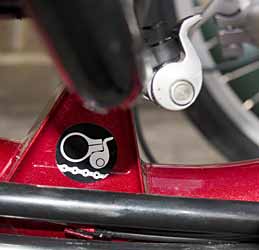
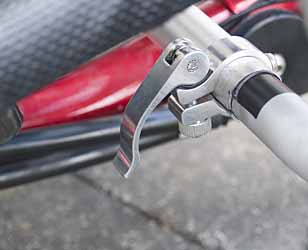
Above left: The quick release and collar which hold the seat down onto the mounting. Being under the seat it is quite awkward to access. Right: The optional QR for locking the bars in place (a collar and allen headed screw are standard). Again, this is under the seet, and awkward to access when the seat is in place. A lot of force is required if the bars are not to rotate (which means the upright part you hold moves backwards and forwards), and getting this just right is tricky. I experimented a bit with the position of the QR mechanism, which is why in this picture it is actually the wrong way round; like this I think it is a bit easier to use, but much less tidy, and the importance of the position, so that it does not worsen the turning circle, is even more critical. I'm not sure that the standard allen key collar and a key may actually be more convenient than the QR - it would be easy enough to revert to this, as the QR kit is an add-on fitted by the customer, and you still have all the original parts. The black tape is simply there to help me to set the bars at the correct width.
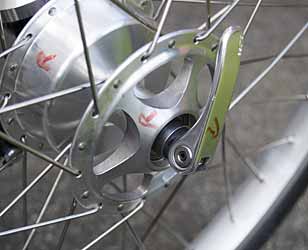
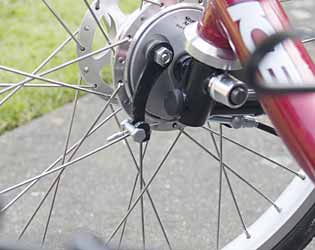
The front hub. The QR makes it easier to remove the front wheels if you need to do this for portability, and I do with the Smart. The standard hex-headed bolt fits into the recess, so the QR, increases the overall width, but without the QR you need two spanners, one of which will need to be a box spanner or ring spanner, or socket, if you are to get the wheels off. Of course you can change a front tube or tyre without having to take the wheel off, so it isn't an issue in riding. The brake cable needs to be unclipped before the wheel can be taken off - just pull the lever on the drum back and slip the bolt over the hook, then unhook the other mounting point.
In the above form I can fairly easily stow the whole machine in the back of my Smart with the passenger seat folded, this being made easier as I am rather short so that the boom is near its minimum extension. However, if you want to make it even smaller, so that it would fit into the back of a Smart even with the passenger seat deployed, you can either move the boom in and/or remove the boom. The optional QR kit allows this to be done by flipping the QR lever on two bolts and then sliding the boom in or out, or without this kit you would slacken two allen bolts. As the photographs and video on the ICE web site show, in this form the machine fits in the Smart with the passenger seat in place and still leaves room to fit in a Brompton as well! If you really needed to make it smaller still, the rear fork assembly/boom could be removed, though this would be a rather fiddly process.
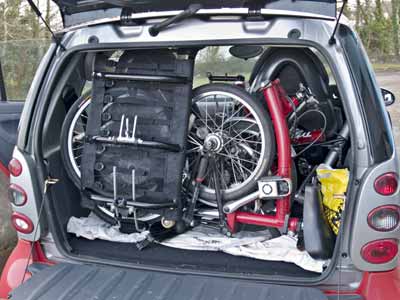
The QNT in the back of a Smart, together with a Brompton, and with the passenger seat still in place. To achieve this the front boom was removed - normally I leave the boom in place, and fold down the front seat. I don't try to fit in a Brompton either!
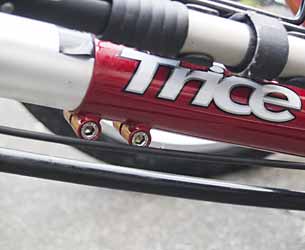 The
two bolts securing the front boom. Normally I don't remove the boom,
so
I prefer to use the standard fixing bolts rather than the option QRs,
which look rather untidy, and require quite a lot of force to close
tightly enough to stop the boom
rotating under pedal pressure. Again
the black tape is just therre to mark the correct boom position for me
in case I do remove it.
The
two bolts securing the front boom. Normally I don't remove the boom,
so
I prefer to use the standard fixing bolts rather than the option QRs,
which look rather untidy, and require quite a lot of force to close
tightly enough to stop the boom
rotating under pedal pressure. Again
the black tape is just therre to mark the correct boom position for me
in case I do remove it.
Reassembly is the reverse of what is described above, though there are a few minor points which need to be mentioned. Firstly, since the QRs for the wheels and mudguards have to be completely removed, refitting them means adjusting the final tension each time, which does take a few seconds longer. With the front wheels I think this is worth it, as this system means you don't need the additional two spanners, though there is also a slight increase in the width of the machine. Although you should be able to leave the handlebar and seat QRs at their original settings, I found that they could rotate enough during removal and transport to lose the setting, so they too needed adjusting each time the machine was reassembled. In the case of the handlebars the setting is really particularly critical - they need to be very tight or the bars can swivel in the steerer tube, which is very disconcerting. I would be inclined to retain the original allen-bolt fixing collars here rather than use the optional QR, as the fixing is more positive and does not take any longer, though it does require an allen key. The optional QR fixing for the front boom needs to be very tight to prevent the boom rotating under pedal pressure; since the threaded collar into which the QR screws is fixed to the frame, the angle at which these QRs end up is fairly arbitrary, and distinctly unsightly - personally I almost immediately replaced these QRs with the original allen head bolts - I don't need normally to move the boom when transporting the machine, but even if I did I would prefer to use an allen key as it is really easier to get the correct tightness of the bolts this way, and the fixing is neater without the QR levers. Refitting the seat can also be rather a fiddly process, not least because the the collars which have to be slid over the mounting are under the seat, so with the machine standing on its wheels on the ground you cannot see what you are doing. The positioning of the collars and their QRs is also quite critical, as if they are in the wrong position they can seriously impede the steering, resulting in a very large turning circle; the correct positioning is shown on a transfer on the frame, but due to the fact that this is all out of sight under the seat, it is a tricky process, and the limited space also means the QRs have very short levers, making it difficult to operate them, and get them reasonably tight.
None of the process is especially difficult, and I will reiterate that describing it makes it all sound more of a performance than it really is, but it does take a little time, and needs to be done carefully. Experience does help of course.
I find that from the time I get out of the car until the machine is assembled and the car locked and ready for me to start the ride takes just a shade over 10 minutes, and about the same for disassembly. This is working at a comfortable speed, and includes time to open/close the tailgate of the car, remove packing sheets around the machine etc. If I removed the front boom, the process would take a little longer. I'll mention a couple more points regarding folding an unfolding later in this report.
I’m not an experienced recumbent bicycle, or tricycle, rider, so my comments will of necessity refer to how I found the QNT, with no direct comparison to other recumbents. In the next section I'll discuss how the experience of a recumbent strikes someone who had almost no prior expereince, but in this section I'll summarise how the Trice has performed over the first 800Km.
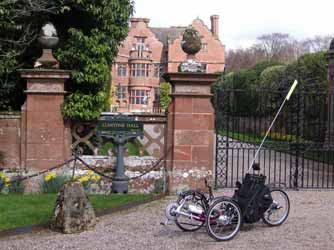
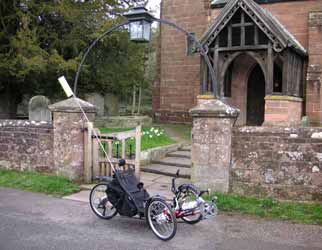
The QNT on its first serious outing in early April, visiting Ludstone Hall and the church at Badger.
For my first couple of rides (after a few quick tests 'around the block'), I put the Trice in the car, and drove 8Km to Highgate Common, then unloaded the Trice and rode from there. Dudley, where I live, is on top of a hill, and the only attractive direction to go for cycling - west - involves undulating roads with a lot of traffic, and a return journey which is predominantly up hill. Usually I ride to and from home, with the option of using a canal towpath for part of the return journey, and a train from Wolverhampton to avoid the least pleasant part of that journey. Unfortuantely the canal towpath and train aren't available options with the Trice, so at least to begin with I decided to use the car. Since those first two outings I've gained confidence, and usually now ride from home, returning via Sedgely - which means a long hill, but at least the road is not as busy as the flatter road route, which uses the main dual carriageway between Wolverhampton and Birmingham, and which is most unpleasant, especially during the week.
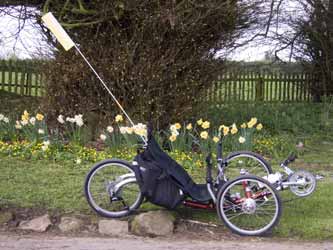
The Trice during another local ride in the spring (27th April)
The standard 52/42/30 triple rings and 11-32 Megarange rear cluster provides a good range of 17.5 - 87.5 inches, nicely spaced, but I fitted the optional 26 tooth smallest front ring to give a lower bottom gear (15 inches). Even on my earliest rides I did feel rather under geared at the top of the range (recumbent trikes can get up a good speed on the flat or downhill), and bottom gear certainly seemed low enough. The gap between the small ring (26 tooth) and middle ring (42 tooth) was really rather large though - equivalent to almost 3 'gears', so that changing to and from the smallest ring tended to involve having to change the rear gear as well. As I gained more experience and developed muscles and technique to suit the different riding position, I was more conscious of the wish to have a higher gear, so I subsequently replaced the 26 tooth ring with the standard 30 tooth one, and substituted an 11-34 rear cluster for the 11-32 - giving a bottom gear a bit lower than the standard, though not as low as the 26 tooth front ring had provided. Additionally, I replaced the 52 tooth standard ring with the optional 55 tooth one, giving in effect an extra half gear at the top of the range. So far I've been very happy with this arrangement - I haven't needed anything lower, and the slightly higher top gear definitely suits me better. In this form the overall range is about 16.5 to 93 inches.
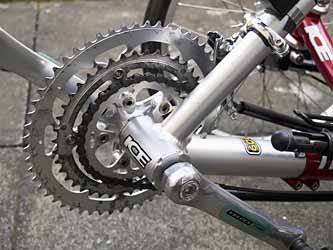 The
chainrings and front changer mount. In this picture the standard middle
and smallest rings are fitted (42 and 30 teeth), but the largest ring
has been replaced with the optional 55 tooth version (in place of 52).
The
chainrings and front changer mount. In this picture the standard middle
and smallest rings are fitted (42 and 30 teeth), but the largest ring
has been replaced with the optional 55 tooth version (in place of 52).
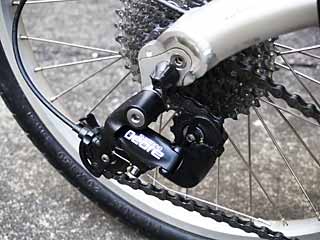 The rear
mechanism. Although
it's not really detectable in the picture, the standard rear cluseter
of 11-32 teeth has been replaced with an 11-34 one.
The rear
mechanism. Although
it's not really detectable in the picture, the standard rear cluseter
of 11-32 teeth has been replaced with an 11-34 one.
Initially I had mixed feelings about the gear change quality; on the preliminary test rides around the block things seemed fine, but one my next few outings I had a lot of trouble with skipping a tooth at the rear, as though it was trying to spontaneously change gear, and then deciding against it. Much fiddling with the adjustment did not seem to help, and I was concerned with the strain this was putting on the transmission. On the third of my longer rides (and the first on which I had started from home), the chain parted just as I was about to go up a rther steep hill in Worfield. Somehow one of the chain pins came partly out, the link swivelled through 90 degrees, jammed in this position, and then jammed in the plastic chain tubes. Unfortunately in getting it apart the chain slipped back into the chain tube, making the repair far more difficult than would normally be the case. In the end I had to completely remove the chain, lean the machine near vertically and then use gravity to help me get the chain back through the tubes. The whole process must have taken about an hour, and a lady who passed me on a horse at the early stages completed her ride and passed me again on her return while I was still finishing the repairs! The remainder of the ride was completed in a state of some nervousness (and extreme oiliness!), but in fact there were no more problems, and the problem with the skipping gears seemed greatly reduced, so perhhaps the removal of one link in the chain had helped, or the link which failed may have been stiff (something I had investigated earlier, without detecting a problem).
On my return from the ride on which the chain broke I spent some more time adjusting the gears, and finally achieved a setting where there were minimal problems with an occasional spontaneous partial gear change/skipping of a tooth. In fact following the success of the ride from home, I did not bother to use the car for transporting the QNT again for several weeks.
A few weeks later I was doing some more adjustments, and I believe in the process I identified the cause of my earlier problems. In folding and unfolding the rear forks, the gear cable tends to get displaced, and the ferrules at the ends of the cable easily come out of the recesses in which they mount. In the case of the one in the rear mech, this is fairly obvious, and I had pushed it back in, but I subsequently found that in the process one strand of the outer cable had become displaced. At the other end, the recessed cable stop is under the seat, and I had not noticed that it was not seated properly. Since removing the damaged centimetre of cable outer, and taking great care to ensure that the cable is properly seated whenever I unfold the machine, gear changing has been excellent.
I find the adjustment of the front changer is extremely critical - it is very difficult to position the front mech so that it does not rub against the chain at one end or the other of the gear range, and has sufficient movement to accurately change rings without deliberately over-changing. At present the best setting involves using the end-stop rather aggressively for the large ring, which means applying quite a lot of force to ensure the twist grip does click into the top gear position. I can't suggest any reason why I should have more problem in getting this set up correctly with the Trice than any other cycle - the components are all standard ones.
Some people do not like twist grip gear changes, and ICE offer a bar-end lever option (at extra cost). Overall, apart from the difficulty mentioned in the previous paragraph, I find the changers work well, and, after tracking down a few problems described earlier, I'm quite happy with the arrangement.
One thing I have found a problem is that when pushing the machine backwards (necessary quite often when manoevering, given the poor turning circle), the chain will come off the rings at the front. I think this is due to the fact that the chain line at the bottom, imposed by the chain tubes and their fixing point, pulls the chain quite strongly towards the centre of the machine, resulting in it coming off the sprockets when the transmission is working in the opposite direction to normal. It is best to makes sure the smallest front ring is selected in this situation, but even then the chain is likely to come adrift.
I'll make some further comments on gearing in relation to recumbents in general in a later section of this report.
On paper, the use of drum, rather than disc, brakes, is just about the only feature of the QNT and its standard Trice cousins which might appear to be open to criticism - but the proof of the pudding lies in the eating. Although the Sturmey drums may not be the greatest when used with large wheels, they seem to me to be entirely satisfactory with 20 inch wheels. I haven't attempted long, high-speed, Apline descents with heavy luggage, but for my riding they seem more than adequate, and better than the brakes on most of my upright two-wheelers (the disc brakes of the Dahon Zero G and the Maguras of the Dahon Jetstream P8 are the only ones that perhaps do feel better). On top of this, though, most reports suggest that these drums are virtually maintenance free, and that the brake shoes will lat almost indefinitely - simplicity and ease of maintenance are important issue to me, and are concerns I have regarding the two folding bikes mentioned in parentheses above.
Of course the other issue that should be mentioned apart from stopping power and maintenance is 'brake steer'. Recumbent trikes normally have two independent front brakes, and no rear brake, and this could potentially mean that if you do not brake evenly on both front brakes the machine will veer to one side or the other. I suppose that when applying the brakes on the QNT there is a faint sensation of pulling just as the first brake starts to bite, but otherwise the QNT performs excellently in this respect, with no trace of 'brake steer'. An optional rear disc brake is available, but this is intended as a parking brake or a drag brake, rather than for normal braking. I suppose if I were planning an Alpine tour, heavily loaded, I might consider this, but for my normal riding I certainly don't need it.
If you stop on a trike on any sort of gradient, it will start to run away, so a parking brake is a necessity. On the QNT this is achieved by pulling one or both brakes on hard, and pushing in a pin on the side of the brake lever to hold it in this position. To be honest, I don't find this very satisfactory - the brake adjustment required to be able to engage the pin in its socket is remarkably fine - a fraction too slack on the brake adjustment and the machine will run away on a very gentle gradient, and a fraction too tight and it is all but impossible to push the pin in. On my very early QNT there was a horrendous rattle from the 'handbrake' pins in normal riding - ICE tell me that they have specified stronger springs on the pins to stop this now, and that a good lump of grease on the levers would solve the problem - it, and a bit of Bluetack, has indeed entirely solved the problem, but it was driving me to distraction before this solution was employed!
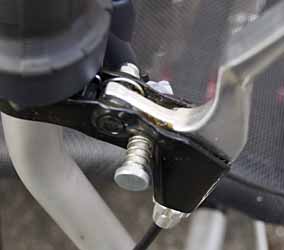 The
brake lever, showing the button that locks the brake on for parking.
The pin just pushes through a hole in the lever, and adjustment of the
brakes is very critical if this is to be effective - if too loose, the
'parking brake' does nothing, but only a fraction tighter and it is
almost impossible to engage the parking button. On this early machine
the spring in the foreground was too weak, resulting in infernal
rattling while riding. Stronger springs are fitted on later
machines,
but in this case a fully effective solution was some grease (a trace of
which is just visible) and a lump of Bluetack at the back (also visible
in the picture).
The
brake lever, showing the button that locks the brake on for parking.
The pin just pushes through a hole in the lever, and adjustment of the
brakes is very critical if this is to be effective - if too loose, the
'parking brake' does nothing, but only a fraction tighter and it is
almost impossible to engage the parking button. On this early machine
the spring in the foreground was too weak, resulting in infernal
rattling while riding. Stronger springs are fitted on later
machines,
but in this case a fully effective solution was some grease (a trace of
which is just visible) and a lump of Bluetack at the back (also visible
in the picture).
I'll address this topic in more detail in the next section on recumbents, so I'll concentrate here on what I think are perhaps Trice (QNT) issues.
I'll start with the suspension, which is new for 2006 to the QNT. The rear suspension consists simply of an elastomer - the very same one used on the Birdy - in compression. This is a simple, foolproof, maintenance-free, light, cheap, reliable, and quite effective system. OK, there are more sophisticated systems around, but personally for cycles I'm very much in favour of this approach. On the Trice, there are three ways of fitting the elastomer, and three stiffnesses of elastomer. In view of my weight (a bit under 9 stone last year, but sadly now over 9 stone!!) I ordered the soft elastomer as well as the standard one, but I've opted for the medium in the end, but fitted in the 'softest' of the three positions.
Overall I find the ride quality very good, but of course with a tricycle it is not as easy to avoid a pothole (or some horse droppings!) in the road. What I DO notice is that roads with a coarse, or damaged, top dressing can induce pronounced high-frequency vibration. In itself you would hardly notice this, but if you try to talk to anyone you are riding with (or sing to yourself, which I'm not inclined to do, except in this case for research purposes), the result is that your voice shakes alarmingly! I noticed this at Cyclefeast last year when I was riding (I was on a Moulton fx8, which does not have this problem) with a Trice rider. I don't have experience of other recumbent trikes (or bikes), so I can't really comment, other than to say: 1) I'd suspect that it is an issue with other recumbent trikes and 2) Using other tyres might at least help. I'll reiterate, apart from the obvious effecting on the voice, I'd not regard this as an issue, and indeed it is food for thought for riders of uprights - the riding position of a recumbent trike makes you aware of this, but is the reason you don't have this problem on an upright that your spine is absorbing this this vibration, without your brain being aware of it?
One of the many things that appealed to me about the Trice specification was that the seat angle is adjustable - apparently it isn't on some recumbents. As someone new to recumbents I was not sure how important that would be, but I felt most reluctant to have no choice in the matter. For my first few rides I used the most upright position, but since then I've switched to the middle position - I do find it slightly preferable to the most upright position, but on the other hand I really don't think anything more reclined than this would suit me.
This is the narrow track version of the Trice standard models, so stability is not quite as high as with the wider track Q model, or the S. Nevertheless, it is still very good, and enormous fun! I've yet to lift a wheel, and at my age I don't plan to (unlike the Gresham Flyer shown at the head of this article, which soon lost the luggage 'boot', parental control stick, mudguards etc, and was often to be seen cornering on two wheels!!). The turning circle is very restricted (partly a function of the narrow track), and turning around requires quite a lot of space, so it is more usual to stop, get off and lift the back to turn it through 90 or 180 degrees, unless on a fairly wide road, or with some space to effect the turn around. Three point turns are a bit nerve racking, especially as using the feet to push the bike backwards usually results in the chain coming off, as mentioned earlier. In normal riding the limited turning circle is not a problem - even tight bends can be managed without difficulty.
With three wheels it is of course not as easy to avoid potholes and other obstacles, but in general I'd say the ride comfort is similar to most decent folders. The use of SPD pedals or clips is highly recommended - if you don't and a foot comes off the pedal it could get dragged under the machine, which would be extremely unpleasant to say the least. Of course, with a trike the usual concerns about using clipless pedals are not a factor, since you can and will stop without needing to take your feet from the pedals, and you won't fall over! For some reason, though I find my feet seem to go numb on longer rides - I haven't yet decided precisely why, or how to solve this. It may the the higher position of the feet compared to a conventional upright bike, or it may be that I am 'clenching' my feet on the pedals (I think I do, though I'm not sure why, or how to stop doing this), or it might be that stiffer soled shoes would help. Partly because of the narrow track of the QNT (which probably affects the turning circle as well), the bars are inevitably quite close to the wheels, though I have no problem in achieving a comfortable position for the hands and arms, not too close to the wheels.
The Kenda Kwest tyres that came on the QNT seem to give good grip and show no signs of wear yet. They are rated for 100psi, but with an extra wheel and a light rider I run them at about 70psi at the moment. This gives reasonable riding comfort, and it is my impression (not done any detailed testing yet though) that below this pressure there is an increase in rolling resistance, but above this pressure the handling becomes a bit skittish. I plan to try some Schwalbe Marathon Racers which I think might be a bit more compliant, but should still roll well. Such a more compliant, lower pressure tyre may also help with the high frequency vibration which results from a damaged top dressing on the road surface - comments from anyone who has experimented in this respect, perhaps using Schwalbe Big Apples, would be welcomed.
My childhood exploits on a trike gave me a lot of enjoyment, and I was very sad in those days that it was not the done thing for an older person to ride a trike, especially as I'm not great at balance (perhaps related to an exceptionally bad head for heights). Anyway, the Trice is in a different league, and provides immense entertainment.
The QNT comes with a rather short, but light rear mudguard, one mirror and a flag, and a range of accessories are available. I bought most of the optional items. The optional front mudguards are of generous length and quite wide, so clearance with even quite wide tyres should not be an issue. They are secured using quick release bolts in place of the bolts in the top of the kingpins, but although the fixing uses a QR-type bolt, in fact the whole bolt has to be unscrewed, using the QR lever as a handle, to remove and secure the mudguard. The mudguard is held on a very robust CNC plate, which makes for a heavy, though very rigid, assembly - the high frequency vibration mentioned earlier probably necessitates the very robust mounting plate, and of course it is only fixed on one side. On the road the vibrations are inclined to result in the fixing bolt working loose unless it is adjusted so that it requires maximum force to close the QR. Because of the weight, and the tendency to work loose, I prefer to leave the mudguards off if at all possible. However, going through a puddle under a bridge on an otherwise dry day has made me aware that water is inclined to fly about everywhere from the front wheels if it is wet, so undoubtedly the front mudgaurds will be needed in wet conditions. The standard rear mudgaurd is reasonably effective, but it is very short, and following riders would not be happy on a wet day. I subsequently ordered the optional more enclosing mudguard. This is very similar to the front mudgaurds in pattern, and again has a very robust CNC mounting bracket. In this case the QR which fixes it only needs to be flipped in order to take the mudguard off. There is only the one mounting bolt, plus an aligning bolt head to stop it rotating about this bolt. I was rather less happy with this mudgaurd - again it is quite difficult to apply enough force to stop it working loose under vibration on the road, and I found aligning it with the wheel extremely difficult; in practice I only use the original standard mudguard, or even no mudguard at all if conditions permit.
Only one set of bottle bosses are fitted as standard, these being on the main frame just before the boom. This makes it difficult to reach the bottle while riding, though it's easy enough to reach it just by sitting up when stationary. The bottle bosses serve also for mounting a mini pump, and also the optional computer mounting kit, which gives a very good view of the computer while riding normally. An optional accessory mount allows a second bottle cage to be mounted behind the seat (or two if you feel the need). I originally decided that I would take this off again as I rarely need more than one bottle, and a second one could be carried in the bags, but in fact I decided to fit it again for the Brevet Populaire (see below) which was on a very hot day, and I've retained it since. Incidentally, with the front boom at nearly its shortest position, to suit my short legs, there is only room to fit one of the smaller size bottles into the cage on the standard mounts - no doubt longer-legged riders would have space for one of the larger bottles which seem more common nowadays.
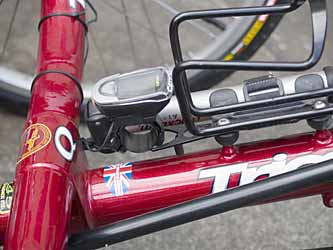 The
single set of bottle bosses serve not just to mount the bottle cage,
but also a mini pump bracket and the optional computer mount. The cable
ties which can be seen in the picture secure the wire to the wheel
sensor for the computer.
The
single set of bottle bosses serve not just to mount the bottle cage,
but also a mini pump bracket and the optional computer mount. The cable
ties which can be seen in the picture secure the wire to the wheel
sensor for the computer.
On the front changer upright I have mounted the optional light bracket, which is in fact a standard Minoura unit which can be used to extend the mounting space on the bars of a conventioanl upright. So far I haven't actually riden in the dark, so although I've put the brackets for lamps on this, I haven't actually got the lights fitted. At the back I have a light mount on the seat headrest, although if your rear lamp has a suitable mounting you could probably mount it direct onto the seat. The head/neck rest is another accessory I've fitted, and it makes it a little easier to attach and remove the bags; although the rest is not normally used in riding, I find it useful ocassionally to be able to lean back on a hill, or when stopped. While on a conventional upright I notice neck discomfort resulting from the need to hold the head back more than in a natural standing position, on the recumbent the problem is if anything the opposite - the head is bent forward to look straight ahead, especially if you wear bifocal or varifocal glasses, and while this is much less tiring than holding the head back, it can produce very mild discomfort on a long ride.
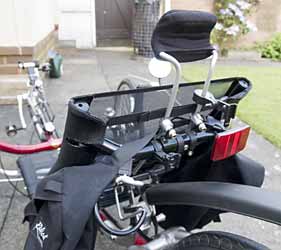 Quite
a number of optional accessories are visible mounted on the back of the
seat - the additional bottle cage mount, neck/head rest, a rear lamp
mount on the the headrest, and a couple of lamp brackets. Also visible
here, though not very clearly, are the standard rear mudguard and its
mount and the rear support for the seat, which enables the seat to be
set at three fixed angles. The red rear suspension elastomer is also
just visible.
Quite
a number of optional accessories are visible mounted on the back of the
seat - the additional bottle cage mount, neck/head rest, a rear lamp
mount on the the headrest, and a couple of lamp brackets. Also visible
here, though not very clearly, are the standard rear mudguard and its
mount and the rear support for the seat, which enables the seat to be
set at three fixed angles. The red rear suspension elastomer is also
just visible.
For luggage I use the Radical bags, which are absolutely brilliant. With a capacity of 25 litres they are far more than adequate for any day ride, and should suffice for a long weekend as well - indeed, may people could probably do a week tour using B&B with just these bags. On top of this they are extremely light, and require no carrier, as they simply hang over the seat, and are very quickly and easily removed and refitted. As a final bonus, you can easily reach into the bag to get at things while riding along. For more capacity there is an optional rear rack available onto which conventional panniers can be attached. This is a very robust looking unit (I don't have one), but must add quite a bit of weight. It incorporates a rear mudguard and lamp mountings, and can be quickly fitted or removed via a QR. There is also a larger version of the Radical bags available - I'd be more tempted by this than conventional panniers if I felt I needed more capacity than the smaller Radicals provide, but unfortunately to use the larger one you need the rack except with the S model - presumably to stop the bags swinging against the rear wheel. The final luggage option is a mount to take a conventional handlebar bag mounted on the right or left side (or both) alongside the seat. Now the Radical bags are available I can't see this being a very popular option, as the Radicals offer more capacity, are lighter, cheaper and just as convenient for accessing things while riding.
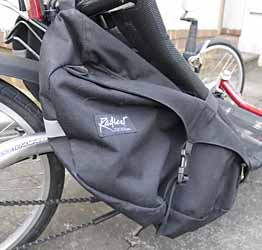 The really
excellent Radical bags -
very light, easily attached and removed, very capacious, and accessible
while you ride along (note the zip opening at the front).
The really
excellent Radical bags -
very light, easily attached and removed, very capacious, and accessible
while you ride along (note the zip opening at the front).
For me, 100Km is quite a long ride, though I probably do this distance several times a year (I have set myself a target of doing 10 of these, in Brevet Populaire form, in 2006, plus a few rides done by myself of similar distance). I had done another 100Km ride on the QNT on my own a week before tacking the Cheswick Green event, and did another ride of 114Km 10 days later. Earlier in the year I'd done four other 100Km Brevet Populaires - for one I actually used a conventional diamond-framed bike, rather than a folder, for the first time on such an event! In the corresponding event last year I rode with Susan Barlow, Dave Minter, Tony Hadland, Paul Evans and Dick Hanson, all of whom were on folders or Moultons, but for 2006 I was on my own (apart from a couple of hundred other riders!). Last year's event was superbly organised, with an excellent route - quiet roads, few hills, excellent route sheet etc. This year's event was just as well organised, agan enjoying good weather, and to handle the enormous popularity it had been extended so that there were 2 100Km rides (same route for both, but the first going round clockwise, and the second anti-clockwise), so that more entrants could be handled (many had to be turned away last year); in addition to the 100Km rides there were longer rides available as well. I put the QNT in the Smart the evening before, experimenting with yet another way of fitting it in. I allowed myself time to be there about 45 minutes before the start, giving plenty of time to reassemble the machine, register etc. This year parking was in a large field, with very long grass, so it was very important not to drop anything while reassembling the machine as it would be difficult to find anything in the grass. I took the front mudguards with me in the car, but the excellent weather meant that there was need for them, and given their weight and tendency to work loose I did not fit them for the ride. I had to push the QNT out of the field due to the length of the grass and the rough surface - and pushing a recumbent trike is rather awkward. Some grass needed to be removed from the rear mech after this.
Despite the large number of people at the event I saw only one small wheeler, one folder, one recumbent and one tricycle - all being my own Trice! There were some conventional upright tandems, but otherwise conventional diamond frames were the order of the day.
Food and drink were available at the start, but I didn't take advantage of this, although I had plenty of time. An updated large-print version of the route sheet, with graphical symbols to indicate turnings etc was available at the start to supplement the original sheet sent out before the event, and though there had been no change in the route I opted to use this. Lacking a place to mount a map holder on the QNT (I usually use a R&K mini map holder mounted on the bars or stem on an upright) I was using an Ortleib map holder hung round my neck. This was to prove quite good for containing the map in an easily accessible position, but its tendency to blow about was a real nuisance, and I will need to find some better solution before using the QNT for one of these rides again.
We duely got underway at 9:15 - I deliberately set out last, as I expected to be one of the slowest riders (as I usually am on a more conventional upright), and the trike could be a bit of 'moving chicane' in a large group. After about 5 Km I made a brief stop to fix a slight rattle caused by the end of the gear cable having been bent so that it could contact the spokes. At this point I realised I had forgotten to attach the flag - I did not feel inclined to lose time and increase my distance by going back for it, which left me feeling rather less secure than usual for the rest of the ride, though nothing occurred to suggest that anyone had difficulty seeing me. After this stop I was a little way behind any other riders, but after 20 minutes or so I did catch up a few slower riders, and later some people who had stopped to fix a puncture.
The first stage out to Wellsbourne Airfield was predominantly down hill, and was accomplished very well within the allowed time. I usually make only a very brief stop at controls, and after pausing to try (unsuccessfully as it turned out) to secure the map holder better to prevent it blowing about, I set out on the second stage. Once again this was pretty flat to start with, with remarkably little traffic about, and I continued to make steady and very enjoyable progress. Some consternation was felt at the second information control, where we were supposed to note down the name of a board at a construction site - unfortunately work seemed to have been complete on the site, and we can only assume the board had been taken down, as there was no sign of it! Everyone decided to note down some other item of local information, and then proceeded on their way. The easy progress was slightly disrupted by a steep hill near Welford, and the local village fete also enlivened things at the second control stop. Again my stop was quite brief, so there were quite a number of riders behind me when I started on the final stage, many of whom would overtake me before the end.
![]() The
final stage involved more
climbing to get back to the start/finish, although for the most part
this was fairly gentle. It was interesting to note that although I was
slower than most other riders (as I always am), this was not
particularly the case going up hill, and I was not falling behind by
any more than I would have done on an upright bike - in fact possibly
less. About 10Km from the finish the only incident relating to the
performance of the
QNT occurred. I'd been overtaken by some Solihull CC riders earlier,
but had generally been keeping up with them since, and was finding the
tow useful. Just after a gentle climb, rounding a gentle bend, the seat
came adrift, which was quite exciting, as it is very difficult to steer
and brake when the seat is not attached to the cycle! I managed to stop
safely, just avoiding hitting the kerb, and got off to investigate. I
must thank the Solihull riders, who hearing a noise behind them stopped
and came back to see if I was alright, and if I needed any help.
Incidentally, riders from the same club were equally helpful when I had
a problem with the Airnimal a couple of years ago. Nothing was broken,
it just seemed to be a case of the clamping collars under the
seat having slipped, meaning that the front location was
missing, and the rear location had pulled out under the load. I'd riden
90Km at this stage, but it's possible I hadn't quite got the collars
into the right position, or did not have the QRs fixed quite tight
enough - being under the seat, the fixing is awkward, as mentioned
earlier. I will certainly be very careful to check this out in future.
Obviously all I needed to do was refix the seat, so I sent the Solihull
riders on their way with thanks, and quickly sorted things out and
resumed the ride, the remainder of which was uneventful. I arrived back
in very good time, feeling quite relaxed, although perhaps glad that I
hadn't got any further to go. Not only was there free food and drink
available again at the end, but also a free water bottle commemorating
Beacon RCC's 60th anniversary (Beacon are the organisers, picture on
the right). They also
had pens with their own logo on available at the start (see top of this
section), which could be
used to note down information control details during the ride!
The
final stage involved more
climbing to get back to the start/finish, although for the most part
this was fairly gentle. It was interesting to note that although I was
slower than most other riders (as I always am), this was not
particularly the case going up hill, and I was not falling behind by
any more than I would have done on an upright bike - in fact possibly
less. About 10Km from the finish the only incident relating to the
performance of the
QNT occurred. I'd been overtaken by some Solihull CC riders earlier,
but had generally been keeping up with them since, and was finding the
tow useful. Just after a gentle climb, rounding a gentle bend, the seat
came adrift, which was quite exciting, as it is very difficult to steer
and brake when the seat is not attached to the cycle! I managed to stop
safely, just avoiding hitting the kerb, and got off to investigate. I
must thank the Solihull riders, who hearing a noise behind them stopped
and came back to see if I was alright, and if I needed any help.
Incidentally, riders from the same club were equally helpful when I had
a problem with the Airnimal a couple of years ago. Nothing was broken,
it just seemed to be a case of the clamping collars under the
seat having slipped, meaning that the front location was
missing, and the rear location had pulled out under the load. I'd riden
90Km at this stage, but it's possible I hadn't quite got the collars
into the right position, or did not have the QRs fixed quite tight
enough - being under the seat, the fixing is awkward, as mentioned
earlier. I will certainly be very careful to check this out in future.
Obviously all I needed to do was refix the seat, so I sent the Solihull
riders on their way with thanks, and quickly sorted things out and
resumed the ride, the remainder of which was uneventful. I arrived back
in very good time, feeling quite relaxed, although perhaps glad that I
hadn't got any further to go. Not only was there free food and drink
available again at the end, but also a free water bottle commemorating
Beacon RCC's 60th anniversary (Beacon are the organisers, picture on
the right). They also
had pens with their own logo on available at the start (see top of this
section), which could be
used to note down information control details during the ride!
This is really an outstanding ride to take part in, and this year it was every bit as good as the one in 2005: many thanks to the organisers for such a superb event. Apart from the excitement with the seat, the Trice performed perfectly, and I doubt that I would have gone round any quicker on a conventional upright bike, and I was certainly less tired and in generally better condition than I would have been using a conventional machine. Anyway, these are not races, and so speed of doing the ride is immaterial so long as it is completed within the maximum (and minimum) allowed time.
Putting the QNT back in the car
for the return journey presented no problems, but the car had evidently
not enjoyed being abandoned in the middle of a field on a hot day, as
the starter motor was most reluctant to turn the engine over. It
finally just managed it at the third attempt, much to my relief, but
when I tried to start it a few days later I had similar problems, so a
new battery had to be fitted.
I'm quite new to recumbent riding - other than a few miles on a borrowed Bike Friday SatRDay recumbent two-wheeler last year, the QNT is the only recumbent I've ridden, apart from a lap or two of the campus at Cyclefest on various models of tricycle a few years ago. I have lusted after a recumbent trike for several years, but the high prices at that time, the lack of portability and other practical considerations meant that I did not get one. With the quite modest price (for what you get), some portability, and the awareness that if I did not get one now there would really not be much more chance to (I turned 60 in 2005), I took the plunge, and I can say with no hesitation that I'm delighted that I did, and that I only wish I had got one before! My observations on how it feels to ride a recumbent are of course just my own views, and other people may feel differently about them.
My earlier, fairly brief, experience of a recumbent two wheeler had been interesting, but supported the view which is often expressed that they are more difficult to balance than a more conventional upright, and that in particular starting on an uphill gradient can be very tricky - you can't stand on the pedals to get going, and you have to push off very positively and get your second foot on the pedal quickly - any hesitation or insufficient commitment, and there isn't time to put a foot down and try again, you will fall off. For this reason I decided that a trike was definitely the way I would prefer to try the recumbent experience.
Recumbents, particularly trikes, are often referred to as being very fast down hill, but rather slow going up. I was prepared to find hill climbing hard work, and it was largely for this reason than I went for the optional 26 tooth small chain ring. Going up hill is certainly not fast, and I would say that I'm definitely slower than I would be on an upright bike. However, although it may be harder work on the legs, everything else about it is much easier - you just sit there and pedal away in a low gear and winch yourself up the hill, without any effort being expended in keeping balance, weaving round small obstacles, pulling on the bars etc. In practical terms I think that even if I lose a bit of speed on the ascent, and the legs work harder, the overall effort is quite possibly less, and I arrive at the top feeling less exhausted. The more open riding position also probably helps with breathing. As mentioned earlier, after some experience I revised the gearing, and reverted from the optional smaller chainring to the standard one, and raised the top gear, while using a slightly wider rear cluster.
Downhill it is certainly enormous fun, and fast, though perhaps not as much more so than a more conventional upright as some people suggest. This experience of descending and climbing is rather supported by my experience at Cyclfeast in 2006 - on a longer ride with some younger, stronger, riders on recumbent trikes (I was riding a Moulton fx8), they were surprised how well I kept up down hill (and I'm a rather nervous, slow descender), but they could leave me behind on climbs.
Overall I would say that I am 5-10% slower than on an upright bike, but although I may be slower, I feel much less tired after a ride, and the saddle/neck/shoulder discomfort that I normally feel at the end of a long ride is completely absent. After a long ride on an upright bike I often have difficulty sleeping the following night, despite feeling tired; this does not seem to be a problem either after using the Trice.
One factor in performance up hill will of course be weight. Most of my light upright bikes seem to end up weighing about 28 pounds ready for the road (including mudguards, luggage, tools etc), though a couple do end up a shade more. I weighed the QNT in equivalent form (but without the front mudguards), and it is 42 pounds. Comparing the standard Trice range with its much more expensive custom-built Trice cousins, quality (and hence weight) of the components, and overall weight seem the only significant differences (apart from the sheer variety of designs in the custom range); the standard models are quoted at a few pound heavier than the custom models. The ICE specification quotes the weight of the Q as 36 pounds, excluding accessories, so my ready for the road weight, including pedals, a number of accessories and basic luggage and tools seems reasonable! Assuming the QNT is about 14 pounds heavier than an equivalent upright, that must have quite an effect on hill climbing, but seems a reasonable figure given the extra wheel, the seat etc. Interestingly some two wheeled recumbents have quoted weights not very different from the QNT, so I think it is quite acceptable, though a lighter custom model would be very nice, if I could afford it!
As far as comfort of ride goes, it is very good. Recumbents are sometimes described as being better for people with back problems. I don't suffer much in that way (though I do sometimes get twinges). For someone who does not have major problems in this respect, I'd say personally that I find the recumbent is better, though the fact that you push on the seat with your back to apply force to the pedals means that it is not necessarily the solution to such problems, and I'd suggest that anyone considering a recumbent specifically for back problems should take expert advice. One friend with bad back problems tried a recumbent trike and found it a disaster, and has reverted to a conventional upright bike. Also bear in mind that lifting a heavy recumbent into a car might not be good for your back either (serious point, not just being flipant). In the case of a recumbent tricycle, most are quite low, so for people with mobility problems getting in and out of the seat may be an issue too. As far as comfort of the seat goes, personally I get much less discomfort from the mesh hammock style seat than from the saddle of a conventional bike - no saddle soreness at all. I haven't ridden a recumbent with a hard shell type of seat, but I believe the back can get very hot on these - there is certainly no problem of this kind with the mesh seat of the QNT. Where I notice a BIG improvement myself is in terms of neck and shoulder discomfort - virtually none at all on the Trice, but I frequently do feel discomfort on upright bikes, whether with flat or dropped bars. One thing I might add about the riding position is that in sunny weather sun block is VERY important - the legs and arms are in a more horizontal position, and you can easily get badly sunburnt.
Recumbents are fun, but they do have some practical problems, notably in terms of the obstacles found on cycle paths, towpaths etc, and the inability to take advantage of trains in most situations. These factors do limit how much I use it - my most common ride, for example, would ideally involve using 10Km of towpath and a 5 minute train journey, in order to avoid some unpleasant hills and busy roads. As yet there aren't very many recumbents (bikes or trikes) which can be carried easily in a car, and even though the Trice and, for example, the SatRDay can be folded and/or separated, it is still quite a bit more work to get them in most cars than it is for an upright folder, or separable Moulton.
The other concern some people feel about recumbents is vulnerability on busy roads and in traffic. But then non-cyclists say the same about conventional bikes! Motorists who see you generally give you a very wide berth, but the concern must be whether they do see you. A flag certainly helps (though encounters with horses can be a real problem). Encounters with large tractors of HGVs can be rather worrying, and with a trike your options for retiring off the road are much more limited. The prospect of being stationary at traffic lights or a junction with a large, tall HGV alongside or behind does worry me - if the driver forgets you are there, your visibility will be low. So far I have only had one really worrying incident - as I was riding along a straight, quite wide, main road, with very little traffic, a BMW started overtaking me and then swerved across, while still alongside me, to turn left. There was no question of the driver not seeing me, as he would have driven over me if he had not, nor of misjudging the speed, as I was going relatively slowly on a gentle up hill gradient, and he was still alongside when he started to turn. Only a full scale emergency stop right in the gutter enabled me to avoid being hit. The same thing has happened to me twice on conventional bikes, so it was not a recumbent trike issue. On the whole I don't find it an unacceptable issue, though I certainly do feel more vulnerable than on a conventional bike, and keep an even closer eye open for potential problems and escape routes than I do when riding an upright.
It’s really not up to me to say who will enjoy the recumbent experience, and certainly by the nature of things even folding models are not going to be as compact as those more conventional folding bicycles which are designed specifically for mixed-mode commuting. However, if a recumbent appeals to you, then the new Trice standard range for 2006 must be very high on your list of desirable machines. The rear suspension is very effective, and gives a very comfortable ride. Handling, braking and gearing are excellent, quality is beyond criticism, and the choice of components, and their quality, is appropriate. Portability, and bulk when stored, are addressed very effectively, and ICE are to be commended for this - under 10 minutes to fold/split, only a shade more to re-assemble, and a package which will fit into the luggage space of a Smart Fortwo, and still leave room for a Brompton for the passenger. With a larger vehicle to transport it, less disassembly would be required, and the process would be even quicker. ICE plan a carry bag for the folded/disassembled machine - using this, train travel would become quite feasible, though clearly the amount of assembly and disassembly means this is an option for a day ride, or start and end of a holiday, rather than something one would choose to do for daily commuting.
In terms of value, this may be the 'standard' ICE range, but there are no compromises in terms of quality or components in any major areas. In the UK, these are excellent value compared with other trikes and recumbent bikes - and indeed are a bargain compared with many reasonable quality conventional bicycles.
I can thoroughly recommend the Trice QNT - it is a well specified, very high quality recumbent, enormous fun to ride, and the portability makes it far more practical than most earlier recumbents, both tricycles and bikes.
Inspired Cycle Engineering
Unit 9b, Spencer Carter Works, Tregoniggie Ind Est, Falmouth, Cornwall
TR11 4SN, UK
Tel & Fax: 01326 378848
Web: http://www.ice.hpv.co.uk
email: sales@ice.hpv.co.uk
Copyright (C)2006
Ferrets Anonymous
Last
updated: 20 June 2006